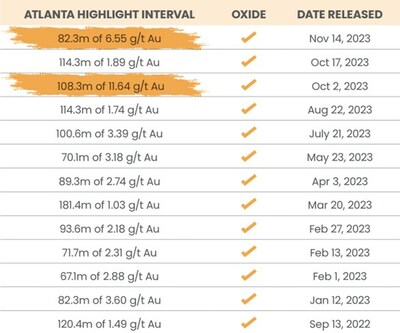VANCOUVER, BC, Dec. 14, 2023 /PRNewswire/ - Nevada King Gold Corp. (TSXV: NKG) (OTCQX: NKGFF) ("Nevada King" or the "Company") is pleased to provide an update on its Phase II resource expansion and definition drilling program at its 5,166 hectare (51.6km2), 100%-owned Atlanta Gold Mine Project, located in the prolific Battle Mountain Trend 264km northeast of Las Vegas, Nevada.
Highlights:
- Since inception of the Phase II Atlanta drill program in June 2022 Nevada King has completed 372 holes totaling 69,683m, which include 354 reverse-circulation ("RC") holes totaling 67,760m and 18 core holes totaling 1,923m. Prior to initiating the Phase II program the Company completed 68 holes totaling 5,544m in its maiden Phase I program.
- To date, as part of its Phase II program, Nevada King has reported assays from 204 holes covering 35,915m with results from 168 drill holes totaling 33,768m currently pending.
- Four rigs continue to operate at Atlanta. Drilling for 2023 will wrap up on December 17th for the Christmas break and all four rigs are scheduled to recommence drilling the first week of January.
- Phase II drilling has led to the discovery of new zones of high-grade gold and silver mineralization both within and outside of the currently defined resource area including 11.64 g/t Au over 108.3m in AT23WS-44 and 6.55 g/t Au over 82.3m in AT23NS-133F (released October 2, 2023, and November 14, 2023, respectively).
- A major focus of ongoing drilling is to follow up on elevated high-grade (>20 g/t Au) intercepts scattered throughout the deposit with the goal of further defining the spatial distribution of this exceptionally high-grade oxide mineralization for potential inclusion as discreet domains in upcoming resource modeling (see Figure 1).
- Drilling is also ongoing at the southern end of the Atlanta resource zone following the blind discovery of thick, high-grade gold mineralization including 1.89 g/t Au over 114.3m and 2.15 g/t Au over 96.0m released on October 17, 2023. Mineralization remains open southward along a major structural zone that has seen no historical drilling.
Cal Herron, Exploration Manager of Nevada King, commented, "Results to date from our Phase II drill program have significantly exceeded our expectations. We have consistently intercepted high-grade mineralization over significant thicknesses both within and around the resource modelled by Gustavson in 2020, as illustrated by the previously released highlight intercepts summarized in Table 1 below. Our understanding of the controls on mineralization have improved significantly since 2020, with deeper and more closely spaced holes having now defined the geometry and location of high-angle faults that served as conduits or feeders for Au/Ag-bearing hydrothermal fluids cutting up through sub-horizontal replacement horizons within the Paleozoic and Tertiary age stratigraphy. As a result, Nevada King has now been able to tie together higher grade zones along the northerly-trending Atlanta Mine Fault Zone ("AMFZ") and adjacent West Atlanta Graben Zone ("WAGZ").
"In the process of drill-defining these higher grade feeder structures, several high-grade zones exceeding 21 g/t Au equivalent were encountered in multiple locations in the drilling (see Table 2). As shown in Figure 1, these elevated high-grade intercepts are scattered throughout the target resource area but tend to occur along or immediately adjacent to high-grade feeder faults. These holes tend to cluster along NW trends that may indicate very localized hydrothermal boiling within dilational zones that opened up at acute angles to the predominant northerly trending feeder-faults. Ongoing drilling will focus on close-spaced step-outs around these elevated high-grade intercepts with the objective of growing them into larger bodies that could be included as discreet high-grade zones in the upcoming resource model. In the process of doing so and based on our current interpretation we anticipate a strong likelihood of encountering additional high-grade "jewelry boxes" along and between the major fault strands."

Hole No
| From (m)
| To (m)
| Interval (m)
| Au Eq. (g/t)
|
AT23WS-044
| 274.4
| 303.4
| 29.0
| 37.71
|
AT23NS-133F+
| 187.5
| 195.1
| 7.6
| 33.72
|
AT22HG-13
| 167.7
| 172.3
| 4.6
| 33.25
|
AT23HG-37
| 224.1
| 227.1
| 3.0
| 34.13
|
AT23HG-18
| 262.2
| 265.2
| 3.0
| 33.33
|
AT23WS-22
| 292.7
| 300.3
| 7.6
| 28.81
|
88-09
| 161.6
| 173.8
| 12.2
| 33.87
|
AC-01
| 149.5
| 153.7
| 4.1
| 32.09
|
88-14
| 158.5
| 161.6
| 3.0
| 36.15
|
KR97-01+
| 196.6
| 201.2
| 4.6
| 22.15
|
Table 2. List of Nevada King and historical drill holes reporting minimum 3m thick intercepts exceeding 21 g/t Au equivalent based on a November 6, 2023, USD spot price of $1,981.50 (gold) and $23.10 (silver). AT series holes drilled by Nevada King, 88 series holes drilled by Bob Cat in 1988, AC series hole drilled by Goldfields in 1989, and KR series hole drilled by Kinross in 1997. Mineralization occurs along near-horizontal horizons with true mineralized thickness in vertical holes estimated to be 85% to 100% of reported vertical drill intercept length. *Denotes angle hole.
|
QA/QC Protocols
All RC samples from the Atlanta Project are split at the drill site and placed in cloth and plastic bags utilizing a nominal 2kg sample weight. CRF standards, blanks, and duplicates are inserted into the sample stream on-site on a one-in-twenty sample basis, meaning all three inserts are included in each 20-sample group. Samples are shipped by a local contractor in large sample shipping crates directly to American Assay Lab in Reno, Nevada, with full custody being maintained at all times. At American Assay Lab, samples were weighted then crushed to 75% passing 2mm and pulverized to 85% passing 75 microns in order to produce a 300g pulverized split. Prepared samples are initially run using a four acid + boric acid digestion process and conventional mutli-element ICP-OES analysis. Gold assays are initially run using 30-gram samples by lead fire assay with an OES finish to a 0.003 ppm detection limit, with samples greater than 10 ppm finished gravimetrically. Every sample is also run through a cyanide leach for gold with an ICP-OES finish. The QA/QC procedure involves regular submission of Certified Analytical Standards and property-specific duplicates.
Qualified Person
The scientific and technical information in this news release has been reviewed and approved by Calvin R. Herron, P.Geo., who is a Qualified Person as defined by National Instrument 43-101 ("NI 43-101").
About Nevada King Gold Corp.
Nevada King is the third largest mineral claim holder in the State of Nevada, behind Nevada Gold Mines (Barrick/Newmont) and Kinross Gold. Starting in 2016, the Company has staked large project areas hosting significant historical exploration work along the Battle Mountain trend located close to current or former producing gold mines. These project areas were initially targeted based on their potential for hosting multi-million-ounce gold deposits and were subsequently staked following a detailed geological evaluation. District-scale projects in Nevada King's portfolio include (1) the 100% owned Atlanta Mine, located 100km southeast of Ely, (2) the Lewis and Horse Mountain-Mill Creek projects, both located between Nevada Gold Mines' large Phoenix and Pipeline mines, and (3) the Iron Point project, located 35km east of Winnemucca, Nevada.
The Atlanta Mine is a historical gold-silver producer with a NI 43-101 compliant pit-constrained resource of 460,000 oz Au in the measured and indicated category (11.0M tonnes at 1.3 g/t) plus an inferred resource of 142,000 oz Au (5.3M tonnes at 0.83 g/t). See the NI 43-101 Technical Report on Resources titled "Atlanta Property, Lincoln County, NV" with an effective date of October 6, 2020, and a report date of December 22, 2020, as prepared by Gustavson Associates and filed under the Company's profile on SEDAR+ (www.sedarplus.ca).
Resource Category
| Tonnes
(000s)
| Au
Grade
(ppm)
| Contained Au
Oz
| Ag Grade
(ppm)
| Contained Ag
Oz
|
Measured
| 4,130
| 1.51
| 200,000
| 14.0
| 1,860,000
|
Indicated
| 6,910
| 1.17
| 260,000
| 10.6
| 2,360,000
|
Measured + Indicated
| 11,000
| 1.30
| 460,000
| 11.9
| 4,220,000
|
Inferred
| 5,310
| 0.83
| 142,000
| 7.3
| 1,240,000
|
Table 2. NI 43-101 Mineral Resources at the Atlanta Mine
|
Please see the Company's website at www.nevadaking.ca.
Neither the TSX Venture Exchange nor its Regulation Services Provider (as that term is defined in the policies of the TSX Venture Exchange) accepts responsibility for the adequacy or accuracy of this release.
Cautionary Statements Regarding Forward Looking Information
This news release contains certain "forward-looking information" and "forward-looking statements" (collectively "forward-looking statements") within the meaning of applicable securities legislation. All statements, other than statements of historical fact, included herein, without limitation, statements relating the future operations and activities of Nevada King, are forward-looking statements. Forward-looking statements are frequently, but not always, identified by words such as "expects", "anticipates", "believes", "intends", "estimates", "potential", "possible", and similar expressions, or statements that events, conditions, or results "will", "may", "could", or "should" occur or be achieved. Forward-looking statements in this news release relate to, among other things, the Company's exploration plans and the Company's ability to potentially expand mineral resources and the impact thereon. There can be no assurance that such statements will prove to be accurate, and actual results and future events could differ materially from those anticipated in such statements. Forward-looking statements reflect the beliefs, opinions and projections on the date the statements are made and are based upon a number of assumptions and estimates that, while considered reasonable by Nevada King, are inherently subject to significant business, economic, competitive, political and social uncertainties and contingencies. Many factors, both known and unknown, could cause actual results, performance or achievements to be materially different from the results, performance or achievements that are or may be expressed or implied by such forward-looking statements and the parties have made assumptions and estimates based on or related to many of these factors. Such factors include, without limitation, the ability to complete proposed exploration work, the results of exploration, continued availability of capital, and changes in general economic, market and business conditions. Readers should not place undue reliance on the forward-looking statements and information contained in this news release concerning these items. Nevada King does not assume any obligation to update the forward-looking statements of beliefs, opinions, projections, or other factors, should they change, except as required by applicable securities laws.

 View original content to download multimedia:https://www.prnewswire.com/news-releases/nevada-king-approaches-70-000m-in-its-phase-ii-drill-program-results-for-168-holes-pending-at-atlanta-302015150.html
View original content to download multimedia:https://www.prnewswire.com/news-releases/nevada-king-approaches-70-000m-in-its-phase-ii-drill-program-results-for-168-holes-pending-at-atlanta-302015150.html
SOURCE Nevada King Gold Corp.
![]() View original content to download multimedia:https://www.prnewswire.com/news-releases/nevada-king-approaches-70-000m-in-its-phase-ii-drill-program-results-for-168-holes-pending-at-atlanta-302015150.html
View original content to download multimedia:https://www.prnewswire.com/news-releases/nevada-king-approaches-70-000m-in-its-phase-ii-drill-program-results-for-168-holes-pending-at-atlanta-302015150.html









